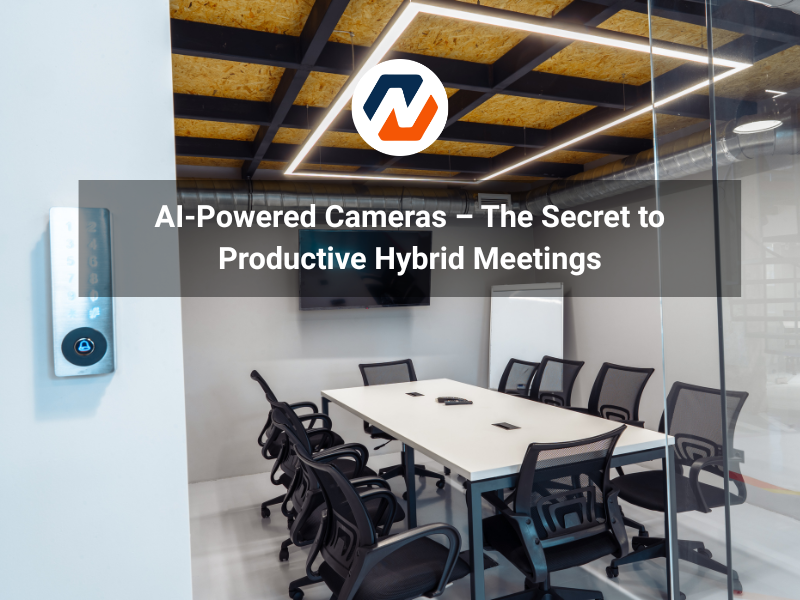admin2025-10-06T16:30:59+00:00
Table of Contents
ToggleIntroduction
Hybrid work is here to stay in Canada—but many boardrooms still struggle with awkward framing, missed cues, and “Can you see me now?” moments. The fastest fix isn’t another training session—it’s AI-powered cameras that automatically frame, track, and spotlight the right people at the right time.
Teams using AI cameras report higher engagement, fewer meeting interruptions, and cleaner recordings for people who couldn’t attend live. For enterprises running on Microsoft Teams Rooms, Zoom Rooms, or Webex Rooms, the upgrade is plug-and-play—and the productivity lift is immediate.
Why traditional cameras hold meetings back
-
Manual control = slow starts. PTZ presets don’t match every meeting layout; someone ends up fiddling with a remote.
-
Narrow framing = remote inequity. When the camera sits on one person, remote attendees miss reactions and side comments.
-
Context switching = lost focus. Pan/zoom mid-meeting breaks flow and distracts speakers.
-
Inconsistent recordings. Bad angles and audio drift make post-meeting reviews painful.
What AI-powered cameras actually do
1) Auto-framing (people-first composition)
Detects all participants and dynamically frames the whole table so everyone is visible—no juggling presets.
2) Active speaker tracking
Smoothly follows the person talking, then eases back to a group view during discussion—keeping the story coherent for remote viewers.
3) Multi-view intelligence
Some models output composite layouts (speaker close-up + room overview + whiteboard view) simultaneously, so far-end attendees never miss context.
4) Whiteboard & content enhancement
AI isolates and corrects the angle of physical whiteboards and in-room displays so remote participants get a legible, front-on view.
5) People counting & analytics
Anonymous occupancy and usage metrics help workplace teams right-size spaces, spot adoption gaps, and plan refreshes.
The measurable upside (what Canadian teams feel day-to-day)
-
Faster starts. One-touch join + auto-framing cuts setup friction; meetings get productive in the first minute.
-
Stronger participation. Remote attendees see faces, reactions, and gestures—so they speak up more.
-
Cleaner recordings. Auto-composed video + consistent audio makes reviews and knowledge-sharing actually useful.
-
Less IT babysitting. Fewer “adjust the camera” interruptions; support teams can focus on higher-value tasks.
Best-fit use cases by room type
Huddle rooms (2–6 people)
-
Ultra-wide AI bars with integrated mic/speaker.
-
Sit anywhere; everyone stays in frame.
-
Perfect for daily stand-ups and client check-ins.
Team rooms (6–12 people)
-
AI PTZ with speaker framing + group reframe.
-
Pairs well with dual displays (people on one screen, content on the other).
-
Ideal for sprint reviews and cross-functional workshops.
Executive boardrooms (12–20+)
-
Multi-camera orchestration: a primary wide shot + one or two speaker cams.
-
AI director modes auto-switch angles like a live producer.
-
Delivers broadcast-quality town halls and investor meetings.
Training rooms & classrooms
-
Instructor-follow + audience mic zoning.
-
Adds whiteboard correction for hybrid learners.
-
Great for onboarding, compliance training, and lecture capture.
AI camera + audio: design it as a system
AI video only shines when audio matches the quality. Pair cameras with:
-
Beamforming ceiling microphones for clear, touchless pickup across the room.
-
DSP echo cancellation to prevent feedback during active speaker tracking.
-
In-ceiling or front-of-room speakers for even coverage without hot spots.
Result: natural conversation flow that feels in-room to remote participants.
Implementation checklist (Canada-ready)
-
Define scenarios (exec reviews, client demos, stand-ups, training).
-
Map room geometry (table shape, sightlines, glass walls, lighting).
-
Select camera class (all-in-one bar, AI PTZ, multi-camera director).
-
Plan dual displays for meeting equity (people + content).
-
Standardize platforms (Teams/Zoom/Webex Rooms images & policies).
-
Harden security (firmware management, signed updates, network VLANs).
-
Pilot in 3 rooms (huddle, team, boardroom), capture adoption metrics, then scale.
Security & manageability for the enterprise
-
Signed firmware & device certificates to prevent tampering.
-
Network segmentation (AV VLANs) and QoS for stable media performance.
-
Remote management (vendor cloud or MDM) for inventory, updates, and diagnostics.
-
Privacy controls (camera shutter policies, LED status, scheduled disable) for regulated sectors like finance and government.
Before / After: what changes with AI cameras
Before: 5 minutes of fiddling, remote people feel like spectators, recordings are “nice to have” but unusable.
After: 30-second launch, in-room and remote feel equal, recordings are clean assets for clients and internal knowledge bases.
ROI snapshot (what leaders care about)
-
Decision velocity: When paired with dual displays, leadership teams report meaningfully faster approvals and fewer follow-ups.
-
IT efficiency: Fewer live interventions; more proactive fleet health via device analytics.
-
People metrics: Higher meeting satisfaction scores and participation from remote staff.
Conclusion
If your hybrid meetings still feel awkward, the bottleneck probably isn’t your platform—it’s the camera. AI-powered cameras make meetings feel natural, inclusive, and efficient by handling framing, tracking, and composition automatically. Pair them with dual displays and beamforming audio, and you’ll turn every room—from huddle to boardroom—into a high-performing collaboration space.

